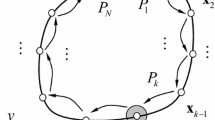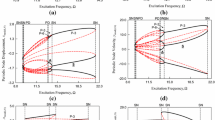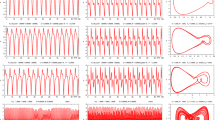Abstract
This paper presents an investigation of limit cycles in oscillator systems described by a perturbed double-well Duffing equation. The analysis of limit cycles is made by the Melnikov theory. Expressing the solutions of the unperturbed Duffing equation by Jacobi elliptic functions allows us to calculate explicitly the Melnikov function, whereupon the final result is a function involving the complete elliptic integrals. The Melnikov function is analyzed with the aid of the Picard–Fuchs and Riccati equations. It has been proved that the considered oscillator system can have two small hyperbolic limit cycles located symmetrically with respect to the y-axis, or one large hyperbolic limit cycle, or two large hyperbolic limit cycles, or one large limit cycle of multiplicity 2. Moreover, we have obtained the conditions under which each of these limit cycles arises. The present work gives the conditions for the arising of limit cycles around the homoclinic trajectory. In this connection, an alternative approach is proposed for obtaining a series expansion of the Melnikov function near the homoclinic trajectory. This approach uses the series expansion of the complete elliptic integrals as the elliptic modulus tends to 1. It is shown that a jumping phenomenon may occur between limit cycles in the analyzed oscillator system. The conditions for the occurrence of this jumping phenomenon are given. A method for the synthesis of an oscillator system with a preliminary assigned limit cycle is also presented in the article. The obtained analytical results are illustrated and confirmed by numerical simulations.












Similar content being viewed by others
References
Guckenheimer, J., Holmes, P.: Nonlinear Oscillations, Dynamical Systems and Bifurcations of Vector Fields, 5th edn. Springer, New York (1997)
Perko, L.: Differential Equation and Dynamical Systems, 3rd edn. Springer, New York (2001)
Wiggins, S.: Introduction to Applied Nonlinear Dynamical Systems and Chaos, 2nd edn. Springer, New York (2003)
Luo, D., Wang, X., Zhu, D., Han, M.: Bifurcation Theory and Methods of Dynamical Systems. World Scientific, Singapore (1997)
Nayfeh, A.H., Balachandran, B.: Applied Nonlinear Dynamics, Analytical, Computational, and Experimental Methods. Wiley, Weinheim (2004)
Andronov, A.A., Leontovich, E.A., Gordon, I.I., Maier, A.G.: Theory of Bifurcations of Dynamical Systems on the Plane. Wiley, New York (1973)
Arnold, V.I.: Geometrical Methods in the Theory of Ordinary Differential Equations, 2nd edn. Springer, New York (1988)
Bautin, N.M., Leontovich, E.E.: Methods and Tools for Qualitative Analysis of Dynamical Systems on the Plane. Nauka, Moscow (1976). (in Russian)
Kuznetsov, Y.A.: Elements of Applied Bifurcation Theory, 2nd edn. Springer, New York (1995)
Chicone, C.: Ordinary Differential Equations with Applications, 2nd edn. Springer, New York (2006)
Christopher, C., Li, Ch.: Limit Cycles of Differential Equations. Birkhäuser, Basel (2007)
Han, M., Yu, P.: Normal Forms, Melnikov Functions and Bifurcations of Limit Cycles. Springer, London (2012)
Han, M., Zhang, T.: Some bifurcation methods of finding limit cycles. Math. Biosci. Eng. 3, 67–77 (2006)
Bonnin, M.: Harmonic balance Melnikov method and nonlinear oscillators under resonant perturbation. Int. J. Circuit Theory Appl. 36, 247–274 (2008)
Bonnin, M.: Existence, number, and stability of limit cycles in weakly dissipative, strongly nonlinear oscillators. Nonlinear Dyn. 62, 321–332 (2010)
Roussarie, R.: Bifurcation of Planar Vector Fields and Hilbert’s Sixteenth Problem. Springer, Basel (1998)
Li, J.: Hilbert’s 16th problem and bifurcations of planar polynomial vector fields. Int. J. Bifurc. Chaos 13(1), 47–106 (2003)
Horozov, E.: Perturbations of the spherical pendulum and Abelian integrals. J. Reine Angew. Math. 408, 114–135 (1990)
Chow, S.-N., Li, C., Wang, D.: Normal Forms and Bifurcation of Planar Vector Fields. Cambridge University Press, Cambridge (1994)
Horozov, E., Iliev, I.D.: On the number of limit cycles in perturbations of quadratic Hamiltonian systems. Proc. Lond. Math. Soc. 69(3), 198–224 (1994)
Horozov, E., Iliev, I.D.: On saddle-loop bifurcations of limit cycles in perturbations of quadratic Hamiltonian systems. J. Differ. Eqn. 113, 84–105 (1994)
Dumortier, F., Li, C.: Perturbation from an elliptic Hamiltonian of degree four—IV figure eight-loop. J. Differ. Eqn. 188, 512–554 (2003)
Zhang, W., Yu, P.: A study of the limit cycles associated with a generalized codimension-3 Lienard oscillator. J. Sound Vib. 231, 145–173 (2000)
Zhang, W., Yu, P.: Degenerate bifurcation analysis on a parametrically and externally excited mechanical system. Int. J. Bifurc. Chaos 11, 689–709 (2001)
Blows, T.R., Perko, L.M.: Bifurcation of limit cycles from center and separatrix cycles of planar analytic systems. SIAM Rev. 36, 341–376 (1994)
Chicone, C., Jacobs, M.: Bifurcation of limit cycles from quadratic isochrones. J. Differ. Eqn. 91, 268–326 (1991)
Savov, V.N., Georgiev, ZhD, Todorov, T.G.: Analysis and synthesis of perturbed Duffing oscillators. Int. J. Circuit Theory Appl. 34, 281–306 (2006)
Georgiev, ZhD: Analysis and synthesis of oscillator systems described by perturbed single well Duffing equations. Nonlinear Dyn. 62, 883–893 (2010)
Georgiev, ZhD, Karagineva, I.L.: Analysis and synthesis of oscillator systems described by perturbed double hump Duffing equations. Int. J. Circuit Theory Appl. 39, 225–239 (2011)
Petrov, G.S.: Number of zeros of complete elliptic integrals. Funct. Anal. Appl. 18(2), 148–149 (1984)
Petrov, G.S.: Non-oscillation of elliptic integrals. Funct. Anal. Appl. 24(3), 205–210 (1990)
Petrov, G.S.: On the nonoscillation of elliptic integrals. Funct. Anal. Appl. 31(4), 262–265 (1997)
Arnold, V.I.: Loss of stability of self-oscillations close to resonance and versal deformations of equivariant vector fields. Funct. Anal. Appl. 11(2), 85–92 (1977)
Oberhettinger, F., Magnus, W.: Anwendung der Elliptishen Funktionen in Physik und Technik. Springer, Berlin (1949)
Janke, E., Emde, F., Lösch, F.: Tafeln Höherer Funktionen. Teubner Verlagsgesellschaft, Stuttgart (1960)
Byrd, P.F., Friedman, M.D.: Handbook of Elliptic Integrals for Engineers and Physicists. Springer, Berlin (1954)
Abramowitz, M., Stegun, I.A. (eds.).: Handbook of Mathematical Functions. National Bureau of Standards, Applied Mathematics Series, vol. 55, U. S. Government Printing Office, Washington (1964)
Lawden, D.F.: Elliptic Functions and Applications. Springer, New York (1989)
Guckenheimer, J., Rand, R., Schlomiuk, D.: Degenerate homoclinic cycles in perturbations of quadratic Hamiltonian systems. Nonlinearity 2, 405–408 (1989)
Wolfram Mathematica 8, Wolfram Research, Inc
Savov, V., Georgiev, Zh, Todorov, T., Karagineva, I., Mastorakis, N., Mladenov, V.: Using the Melnikov function for a synthesis of generalized van der Pol systems. WSEAS Trans. Circuits Syst. 5, 1602–1607 (2006)
Sanjuan, M.A.F.: Lienard systems, limit cycles, and Melnikov theory. Phys. Rev. E 57, 340–344 (1998)
Hasegawa, A., Kodama, Y.: Solitons in Optical Communications. Clarendon, Oxford (1995)
Kivshar, Y.S., Malomed, B.: Dynamics of solitons in nearly integrable systems. Rev. Mod. Phys. 61(4), 763 (1989)
Malomed, B.A.: Variational methods in nonlinear fiber optics and related fields. Progr. Opt. 43, 69–191 (2002)
Uzunov, I.M., Muschall, R., Golles, M., Kivshar, Y.S., Malomed, B.A., Lederer, F.: Pulse switching in nonlinear fibre directional couplers. Phys. Rev. E 51, 2527–2537 (1995)
Olver, P.J.: Applications of Lie Groups to Differential Equations. Springer, Berlin (1986)
Manganaro, N., Parker, D.F.: Similarity reductions for variable-coefficient coupled nonlinear Schrodinger equations. J. Phys. A Math. Gen. 26, 4093–4105 (1993)
Pulov, V.I., Uzunov, I.M., Chacarov, E.J.: Solutions and laws of conservations to coupled nonlinear Schrodinger equations. Lie group analysis. Phys. Rev. E 57, 3468–3477 (1998)
Maimistov, A.I.: Evolution of solitary waves which are approximately solutions of a nonlinear Schrodinger equation. J. Exp. Theor. Phys. 77(5), 727–731 (1993)
Uzunov, I.M., Arabadzhiev, T.N., Georgiev, ZhD: Influence of the higher-order effects on stationary pulses in the presence of linear and nonlinear gain/loss and spectral filtering. Opt. Fiber Technol. 24, 15–23 (2015)
Uzunov, I.M.: Description of the suppression of the soliton self-frequency shift by bandwidth-limited amplification. Phys. Rev. E 82, 066603 (2010)
Uzunov I. M., and Georgiev Zh. D.: Localized pulsating solutions of the generalized complex cubic-quintic Ginzburg–Landau equation. J. Comput. Methods Phys., ID 308947 (2014)
He, Y., Li, Ch.: On the number of limit cycles arising from perturbations of homoclinic loops of quadratic integrable systems. Differ. Equ. Dyn. Syst. 5(3/4), 303–316 (1997)
Feng, B., Hu, R.: A survey on homoclinic and heteroclinic orbits. Appl. Math. E-Notes 3, 16–37 (2003)
Acknowledgements
The authors would like to thank the reviewers for the detailed remarks and recommendations that helped to improve the quality of the article.
Author information
Authors and Affiliations
Corresponding author
Appendix
Appendix
In this section we give some properties and identities concerning the complete elliptic integrals of the first and second kind and the Jacobi elliptic function, which are used in the presentation. Let us recall that the complete elliptic integrals of the first and second kind, \(\mathbf{K}\) and \(\mathbf{E}\), are regarded as functions of m, where \(m=k^{2}\) and k is a modulus. In this case, we have \(\mathbf{K}=\mathbf{K}(m)\) and \(\mathbf{E}=\mathbf{E}(m)\).
The derivatives of the complete elliptic integrals \(\mathbf{K}\) and \(\mathbf{E}\) with respect to m are
The following limit holds
The Legendre’s Relation
at \(m=1/2\) give the inequalities
For small values of m (\(m\ll 1\), or \(m\rightarrow 0+)\) the following series expansion of \(\mathbf{K}\) and \(\mathbf{E}\) are valid:
For values of m close to 1 (\(m\rightarrow 1-)\) the following series expansion of \(\mathbf{K}\) and \(\mathbf{E}\) are valid:
The following integral relations are valid [36] (for shorter expressions the argument of elliptic functions of Jacobi is dropped):
Further let us define the functions
The properties of these functions, used in the presentation, are given in the following lemma.
Lemma A1
The following statements are valid:
-
(a)
\(f(0)=0\), \(f(1)=1\),
$$\begin{aligned} f(m)>0\hbox { and }{f}'(m)=(3/2)(\mathbf{K}-\mathbf{E})>0,\nonumber \\ \end{aligned}$$(A.13)i.e. the function f(m) is positive and monotonically increasing for \(m\in (0 , 1)\).
-
(b)
\(g(1/2)=[2\mathbf{E}(1/2)-\mathbf{K}(1/2)]>0\), \(g(1)=-\infty \) and
$$\begin{aligned} {g}'(m)= & {} \frac{-1}{2m(1-m)}[(2m-1)\mathbf{E}(m)\nonumber \\&+(1-m)\mathbf{K}(m)]<0, \hbox {for }m\in (1/2 , 1),\nonumber \\ \end{aligned}$$(A.14)
i.e. the function g(m) is monotone decreasing for \(m\in (1/2 , 1)\). Moreover, there exists unique value \(m_{ss} \), \((1/2)<m_{ss} <1\), for which we have
(c) \(F(0)=0\), \(F(1/2)=[\mathbf{E}(1/2)-(1/2)\mathbf{K}(1/2)]>0\), \(F(1)=1\),
i.e. the function F(m) is positive and monotone increasing for \(m\in (0 , 1)\).
(d) \(G(1/2)=2[2\mathbf{E}(1/2)-\mathbf{K}(1/2)]>0\), \(G(m_{ss} )=0\), \(G(1)=0\) and
i.e. the function G(m) is monotone decreasing for \(m\in (1/2 , m_{ss} )\).
(e) \(G(1/2)=4F(1/2)>0\), \(G(m_{ss} )=0\), \(F(m_{ss} )>0\) and there exists unique value \(m_1 \), \((1/2)<m_1 <m_{ss} \), such that
Proof
The above statements are proved by using the basic properties of the complete elliptic integrals and the facts already proven in the present lemma. A little more complicated is the proof of the inequality in (A.17) and we will outline it now. Using (A.1) we obtain
The resulting expression is transformed appropriately, for example
\({G}'(m)=4\left[ {(2-5m)(2\mathbf{E}-\mathbf{K})+(\mathbf{E}-\mathbf{K})} \right] <0\) for \(m\in (1/2 , m_{ss} )\).
This proves (A.17). \(\square \)
The graphs of Functions F(m) and G(m) are shown in Fig. 13.
Rights and permissions
About this article
Cite this article
Georgiev, Z.D., Uzunov, I.M. & Todorov, T.G. Analysis and synthesis of oscillator systems described by a perturbed double-well Duffing equation. Nonlinear Dyn 94, 57–85 (2018). https://doi.org/10.1007/s11071-018-4345-4
Received:
Accepted:
Published:
Issue Date:
DOI: https://doi.org/10.1007/s11071-018-4345-4





